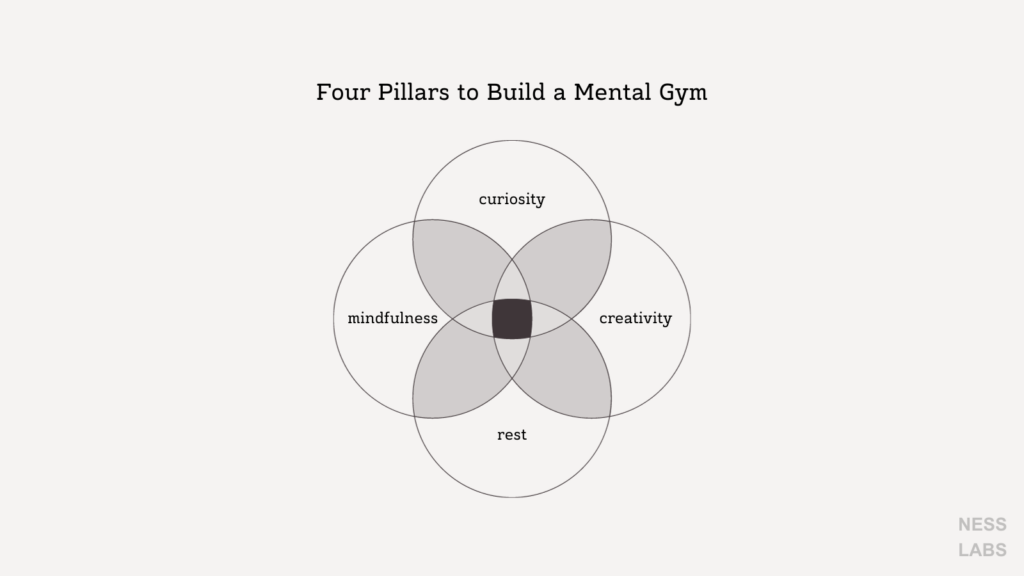At this point, most people are aware of the benefits of physical exercise. Like with many things we know are good for us, it doesn’t mean we actually act on it: it’s estimated there is between $400 million and $1.3 billion spent on unused gym memberships in the U.S. only.
But at least we do know physical activity is good for us. Now, what about mental exercise? Shouldn’t we train our brains, too?
Doing mental push ups
Going to the gym builds muscles over time. This occurs due to muscle fibers tearing during exercise, then repairing and growing bigger and stronger. In a similar way, when we learn new skills or have new experiences, our brains create new neural connections.
The more we stretch our minds, the more connections between neurons our brains can build to adapt to these new challenges.
Building mental strength is not too different from building physical strength. It’s all about consistency. The same way you would take a few minutes to do a few push ups, you can incorporate mental pushups in your daily routine.
And you don’t need any expensive “brain training” games — which don’t even work. There are simple, quick mental activities you can do to use your brain in new and creative ways. In fact, all of the following tools are completely free.
How to build a mental gym
Your mental gym workout should consist of practicing activities that challenge cognitive and emotional skills. Ideally, you need to balance those activities across four pillars: curiosity, creativity, mindfulness, and rest.

Consistency matters more than duration, so experiment with different practices until you find the ones that are the easiest to stick to. Doing mental push ups is something you should be looking forward to.
Practice #1: Be curious
There are many benefits to learning something new. In fact, research suggests that it’s one of the best ways to keep your brain sharp. It may also help you cope with stress. So how can you go about learning something new?
- Read a book
- Listen to a podcast
- Take an online course
- Have a friendly debate
- Learn a new language
- Watch a TED video
- Learn a new skill
- Teach someone
The last one is extremely powerful. Multiple research studies show the positive impact teaching someone else has on the comprehension and recall of any material.
Speaking of recall, a good mental push up is to actually test your memory. The process of retrieving information from your mind will not only make it more accessible in the future, but will also make you a better learner, studies show.
This can be as simple as recalling something you heard in a podcast to tell a friend about it, or writing about a topic you recently learned about from memory before checking your notes.
Practice #2: Get creative
There is evidence that practicing activities such as music, drawing, arts and crafts stimulate our brain in a way that enhances our health and well-being. These activities also have a positive impact on our emotional resilience.
And the good news is that you don’t need to work with an art therapist to get therapeutic benefits from creative activities. It’s become so much easier to find a craft club or artistic activities to do in your neighborhood.
Or, you could just buy some supplies and give it a go with the help of online tutorials. Again, the type of creative practice itself doesn’t matter as much as your ability to stick with it consistently. So choose an activity you enjoy, and don’t be afraid to switch it up.
Practice #3: Be mindful
It’s very easy to go about our busy lives without ever taking the time to reflect on our thoughts and emotions. Between your social and professional obligations, you could in fact wake up and go to bed without a moment for yourself.
Making space to connect with your inner world is crucial to take care of your mind. And being mindful doesn’t have to take a lot of your time.
You can start with a one-minute mindfulness practice. Notice the posture that you’re in. Take a deep breath. Focus on what’s going on around you. It’s just one minute, but it’s a minute where you can be fully present in the moment.
Another great way to be more mindful of your experiences is writing. You don’t need to feel like you’re good at writing to benefit from the practice. Research has found that writing has positive effects on both our psychological and mental health.
In particular, if you need a bit of guidance to tap into your emotions, expressive writing has been extensively studied and is very simple to apply. James W. Pennebaker, the psychologist who devised the method, suggests to do the following exercise for 20 minutes each day for four consecutive days:
- Choose a topic. It should be personal, emotional, and important to you.
- Write for yourself. Do not imagine your writing being read by other people.
- Let go. Don’t worry about style, spelling, punctuation, or grammar.
That’s it. After four days, you can put it away, and come back to it later once you feel ready to reflect on it, but it’s not mandatory. The benefits lie in the exercise itself. If you feel empty or sad after a session, that’s completely normal, and it’s actually good for your brain to experience these emotions—it means you are actively processing them.
Practice #4: Get some rest
All athletes need to rest. Similarly, there’s no need to spend all of your time in your mental gym. Not only is there evidence that taking short breaks can help us better acquire new skills, but longer periods of rest — and in particular sleep —support healthy brain function and the maintenance of your overall health.
According to the National Sleep Foundation, these are the optimal amount of sleep you should get based on your age:
- Teenagers (14-17): 8-10 hours sleep
- Adults (18-64): 7-9 hours sleep
- Older adults (65+): 7-8 hours sleep
A great way to combine short breaks and sleep are, of course… Naps! If you’re fortunate enough to work in an environment where taking a nap during the day is possible, do take that opportunity. Bonus if you’re a student: research shows that taking naps works better for long-term retention compared to cramming.
In short, building a mental gym consists of keeping our brain stimulated with activities that improve our creativity, productivity, and well-being, while giving it space to rest and recharge.
Building your own mental gym takes time to figure out your perfect regimen. Consider this an exercise in deliberate experimentation. Just like an anthropologist, take some field notes to see what works, what doesn’t, and what you could tweak.
